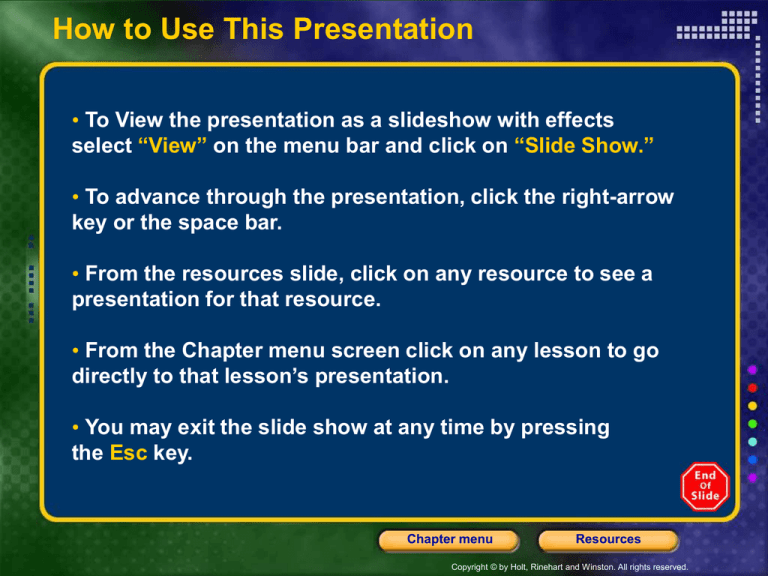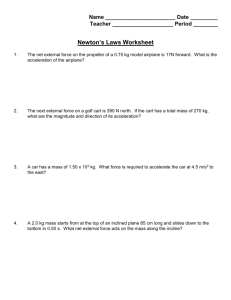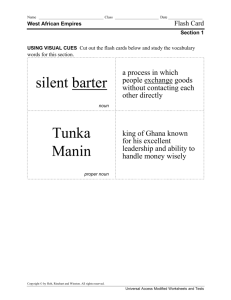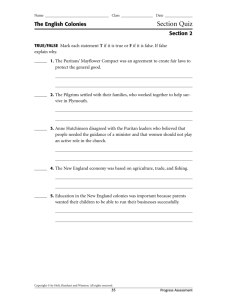
How to Use This Presentation
• To View the presentation as a slideshow with effects
select “View” on the menu bar and click on “Slide Show.”
• To advance through the presentation, click the right-arrow
key or the space bar.
• From the resources slide, click on any resource to see a
presentation for that resource.
• From the Chapter menu screen click on any lesson to go
directly to that lesson’s presentation.
• You may exit the slide show at any time by pressing
the Esc key.
Chapter menu
Resources
Copyright © by Holt, Rinehart and Winston. All rights reserved.
Resources
Chapter Presentation
Transparencies
Visual Concepts
Standardized Test Prep
Chapter menu
Resources
Copyright © by Holt, Rinehart and Winston. All rights reserved.
Chapter 24
Plant Reproduction
Table of Contents
Section 1 Sexual Reproduction in Seedless Plants
Section 2 Sexual Reproduction in Seed Plants
Section 3 Asexual Reproduction
Chapter menu
Resources
Copyright © by Holt, Rinehart and Winston. All rights reserved.
Chapter 24
Section 1 Plant Reproduction
Objectives
• Summarize the life cycle of a moss.
• Summarize the life cycle of a fern.
• Compare and Contrast the life cycle of a moss with
the life cycle of a fern.
Chapter menu
Resources
Copyright © by Holt, Rinehart and Winston. All rights reserved.
Chapter 24
Section 1 Plant Reproduction
Reproduction in Nonvascular Plants
• Like all plants, nonvascular plants have a life cycle
called alternation of generations.
• The structure that produces eggs is called an
archegonium.
• The structure that produces sperm is called an
antheridium.
Chapter menu
Resources
Copyright © by Holt, Rinehart and Winston. All rights reserved.
Chapter 24
Section 1 Plant Reproduction
Alternation of Generations
Chapter menu
Resources
Copyright © by Holt, Rinehart and Winston. All rights reserved.
Chapter 24
Section 1 Plant Reproduction
Reproduction in Nonvascular Plants,
continued
Life Cycle of a Moss
• A moss sporophyte grows from a gametophyte and
remains attached to it.
• Spores form by meiosis inside the spore capsule.
Therefore, as in all plants, the spores are haploid.
• The spore capsule opens when the spores are
mature, and the spores are carried away by wind or
water.
Chapter menu
Resources
Copyright © by Holt, Rinehart and Winston. All rights reserved.
Chapter 24
Section 1 Plant Reproduction
Life Cycle of
a Moss
Chapter menu
Resources
Copyright © by Holt, Rinehart and Winston. All rights reserved.
Chapter 24
Section 1 Plant Reproduction
Life Cycle of Mosses
Chapter menu
Resources
Copyright © by Holt, Rinehart and Winston. All rights reserved.
Chapter 24
Section 1 Plant Reproduction
Reproduction in Seedless Vascular Plants
• Seedless vascular plants can reproduce sexually only
when a film of water covers the gametophyte.
• Some ferns, for example, have sporophytes that are
as large as trees. The sporophytes produce spores in
sporangia.
• A cluster of sporangia on a fern frond is called a
sorus.
Chapter menu
Resources
Copyright © by Holt, Rinehart and Winston. All rights reserved.
Chapter 24
Section 1 Plant Reproduction
Reproduction in Seedless Vascular Plants,
continued
Life Cycle of a Fern
• During the life cycle of a fern, a fertilized egg, or
zygote, grows into a new sporophyte.
• The diploid sporophyte produces spores by meiosis.
• The haploid spores fall to the ground and grow into
haploid gametophytes.
Chapter menu
Resources
Copyright © by Holt, Rinehart and Winston. All rights reserved.
Chapter 24
Section 1 Plant Reproduction
Life Cycle of
a Fern
Chapter menu
Resources
Copyright © by Holt, Rinehart and Winston. All rights reserved.
Chapter 24
Section 1 Plant Reproduction
Life Cycle of Ferns
Chapter menu
Resources
Copyright © by Holt, Rinehart and Winston. All rights reserved.
Chapter 24
Section 2 Sexual Reproduction
in Seed Plants
Objectives
• Distinguish the male and female gametophytes of
seed plants.
• Describe the function of each part of a seed.
• Summarize the life cycle of a conifer.
• Relate the parts of a flower to their functions.
• Summarize the life cycle of an angiosperm.
Chapter menu
Resources
Copyright © by Holt, Rinehart and Winston. All rights reserved.
Chapter 24
Section 2 Sexual Reproduction
in Seed Plants
Reproductive Structures of Seed Plants
• The tiny gametophytes of seed plants develop within specialized
structures that form in the reproductive parts of a flower.
Chapter menu
Resources
Copyright © by Holt, Rinehart and Winston. All rights reserved.
Chapter 24
Section 2 Sexual Reproduction
in Seed Plants
Reproductive Structures of Seed Plants,
continued
• A male gametophyte of a seed plant develops into a pollen
grain, which has a thick protective wall.
• A female gametophyte of a seed plant develops inside an ovule,
which is a multicellular structure that is part of the sporophyte.
• The transfer of pollen grains from the male reproductive
structures of a plant to the female reproductive structures of a
plant is called pollination.
• A pollen tube grows from a pollen grain to an ovule and
enables a sperm to pass directly to an egg.
Chapter menu
Resources
Copyright © by Holt, Rinehart and Winston. All rights reserved.
Chapter 24
Section 2 Sexual Reproduction
in Seed Plants
Pollen Grain Formation
Chapter menu
Resources
Copyright © by Holt, Rinehart and Winston. All rights reserved.
Chapter 24
Section 2 Sexual Reproduction
in Seed Plants
Parts of a Pollen Grain
Chapter menu
Resources
Copyright © by Holt, Rinehart and Winston. All rights reserved.
Chapter 24
Section 2 Sexual Reproduction
in Seed Plants
Ovule Formation in an Angiosperm
Chapter menu
Resources
Copyright © by Holt, Rinehart and Winston. All rights reserved.
Chapter 24
Section 2 Sexual Reproduction
in Seed Plants
Parts of an Angiosperm Ovule
Chapter menu
Resources
Copyright © by Holt, Rinehart and Winston. All rights reserved.
Chapter 24
Section 2 Sexual Reproduction
in Seed Plants
Seeds
• A seed forms from an ovule after the egg within it has
been fertilized.
• The outer cell layers of an ovule harden to form the
seed coat as a seed matures.
• Leaflike structures called cotyledons, or seed
leaves, are a part of a plant embryo.
Chapter menu
Resources
Copyright © by Holt, Rinehart and Winston. All rights reserved.
Chapter 24
Section 2 Sexual Reproduction
in Seed Plants
Seed Structure
Chapter menu
Resources
Copyright © by Holt, Rinehart and Winston. All rights reserved.
Chapter 24
Section 2 Sexual Reproduction
in Seed Plants
Parts of a Seed
Chapter menu
Resources
Copyright © by Holt, Rinehart and Winston. All rights reserved.
Chapter 24
Section 2 Sexual Reproduction
in Seed Plants
Cones
• The gametophytes of gymnosperms develop in
cones, which consist of whorls (circles) of modified
leaves called scales.
• Pollen cones produce large quantities of pollen grains
that are carried by wind to female cones.
• At the time of pollination, the scales of a female cone
are open, exposing the ovules. When a pollen grain
lands near an ovule, a slender pollen tube grows out
of the pollen grain and into the ovule.
Chapter menu
Resources
Copyright © by Holt, Rinehart and Winston. All rights reserved.
Chapter 24
Section 2 Sexual Reproduction
in Seed Plants
Cones, continued
Life Cycle of a Conifer
• In pines, as in all plants, a diploid zygote results from
sexual reproduction. The zygote develops into an
embryo, which then becomes dormant (inactive).
• The embryo and the surrounding tissues form a seed.
When their seeds are mature, seed cones open, and
the seeds fall out.
• When conditions are favorable for growth, the seeds
grow into new sporophytes.
Chapter menu
Resources
Copyright © by Holt, Rinehart and Winston. All rights reserved.
Chapter 24
Section 2 Sexual Reproduction
in Seed Plants
Life Cycle of
a Conifer
Chapter menu
Resources
Copyright © by Holt, Rinehart and Winston. All rights reserved.
Chapter 24
Section 2 Sexual Reproduction
in Seed Plants
Life Cycle of Conifers
Chapter menu
Resources
Copyright © by Holt, Rinehart and Winston. All rights reserved.
Chapter 24
Section 2 Sexual Reproduction
in Seed Plants
Flowers
• Flower parts are arranged in four concentric whorls.
The outermost whorl consists of one or more sepals,
which protect a flower from damage while it is a bud.
• The second whorl consists of one or more petals,
which attract pollinators.
• The third whorl consists of one or more stamens,
which produce pollen.
Chapter menu
Resources
Copyright © by Holt, Rinehart and Winston. All rights reserved.
Chapter 24
Section 2 Sexual Reproduction
in Seed Plants
Flowers, continued
• Each stamen is made of a threadlike filament that is
topped by a pollen-producing sac called an anther.
• The fourth and innermost whorl of a flower consists of
one or more pistils, which produce ovules.
• Ovules develop in a pistil’s swollen lower portion,
which is called the ovary. Usually, a stalk, called the
style, rises from the ovary.
Chapter menu
Resources
Copyright © by Holt, Rinehart and Winston. All rights reserved.
Chapter 24
Section 2 Sexual Reproduction
in Seed Plants
Floral
Structure
Chapter menu
Resources
Copyright © by Holt, Rinehart and Winston. All rights reserved.
Chapter 24
Section 2 Sexual Reproduction
in Seed Plants
Parts of a Flower
Chapter menu
Resources
Copyright © by Holt, Rinehart and Winston. All rights reserved.
Chapter 24
Section 2 Sexual Reproduction
in Seed Plants
Flowers, continued
Flowers and Their Pollinators
• Many flowers have brightly colored petals, sugary
nectar, strong odors, and shapes that attract animal
pollinators.
• Flowers are a source of food for pollinators such as
insects, birds, and bats.
• Many flowers, such as those of grasses and oaks,
are pollinated by wind. Wind-pollinated flowers are
usually small and lack bright colors, strong odors,
and nectar.
Chapter menu
Resources
Copyright © by Holt, Rinehart and Winston. All rights reserved.
Chapter 24
Section 2 Sexual Reproduction
in Seed Plants
Flowers and Animal Pollinators
Chapter menu
Resources
Copyright © by Holt, Rinehart and Winston. All rights reserved.
Chapter 24
Section 2 Sexual Reproduction
in Seed Plants
Flowers, continued
Life Cycle of an Angiosperm
• Following fertilization in an angiosperm, the zygote
and the tissues of the ovule develop into a seed,
which grows into a new sporophyte.
• The adult sporophytes of angiosperms produce
spores by meiosis.
• The fusing of three haploid (n) cells forms a triploid
(3n) cell that develops into endosperm. This is a
process called double fertilization.
Chapter menu
Resources
Copyright © by Holt, Rinehart and Winston. All rights reserved.
Chapter 24
Section 2 Sexual Reproduction
in Seed Plants
Formation of a Female Gametophyte
Chapter menu
Resources
Copyright © by Holt, Rinehart and Winston. All rights reserved.
Chapter 24
Section 2 Sexual Reproduction
in Seed Plants
Formation of a Male Gametophyte
Chapter menu
Resources
Copyright © by Holt, Rinehart and Winston. All rights reserved.
Chapter 24
Section 2 Sexual Reproduction
in Seed Plants
Fertilization of a Flower
Chapter menu
Resources
Copyright © by Holt, Rinehart and Winston. All rights reserved.
Chapter 24
Section 2 Sexual Reproduction
in Seed Plants
Development of a Fruit
Chapter menu
Resources
Copyright © by Holt, Rinehart and Winston. All rights reserved.
Chapter 24
Section 3 Asexual Reproduction
Objectives
• Summarize the characteristics of organic
compounds.
• Compare the structures and function of different
types of biomolecules.
• Describe the components of DNA and RNA.
• State the main role of ATP in cells.
Chapter menu
Resources
Copyright © by Holt, Rinehart and Winston. All rights reserved.
Chapter 24
Section 3 Asexual Reproduction
Vegetative Reproduction
• Plants reproduce asexually in a variety of ways that
involve nonreproductive parts, such as stems, roots,
and leaves.
• The reproduction of plants from these parts is called
vegetative reproduction.
• Many of the structures by which plants reproduce
vegetatively are modified stems, such as runners,
bulbs, corms, rhizomes, and tubers.
Chapter menu
Resources
Copyright © by Holt, Rinehart and Winston. All rights reserved.
Chapter 24
Section 3 Asexual Reproduction
Stems
Modified for
Vegetative
Reproduction
Chapter menu
Resources
Copyright © by Holt, Rinehart and Winston. All rights reserved.
Chapter 24
Section 3 Asexual Reproduction
External Structures of Kalanchoë
Chapter menu
Resources
Copyright © by Holt, Rinehart and Winston. All rights reserved.
Chapter 24
Section 3 Asexual Reproduction
Internal Structures of
Kalanchoë
Chapter menu
Resources
Copyright © by Holt, Rinehart and Winston. All rights reserved.
Chapter 24
Section 3 Asexual Reproduction
Plant Propagation
• Growing new plants from seed or from vegetative
parts is called plant propagation.
• Rhizomes, roots, and tubers can be cut or broken
into pieces with one or more buds that can grow into
new shoots.
• In another technique called tissue culture, pieces of
plant tissue are placed on a sterile medium and used
to grow new plants.
Chapter menu
Resources
Copyright © by Holt, Rinehart and Winston. All rights reserved.
Chapter 24
Section 3 Asexual Reproduction
Methods of Vegetative Plant Propagation
Chapter menu
Resources
Copyright © by Holt, Rinehart and Winston. All rights reserved.
Chapter 24
Standardized Test Prep
Multiple Choice
Use the drawing of a plant seed below to answer
questions 1–3.
Chapter menu
Resources
Copyright © by Holt, Rinehart and Winston. All rights reserved.
Chapter 24
Standardized Test Prep
Multiple Choice, continued
1. Which structure is the embryonic root?
A.
B.
C.
D.
A
B
C
D
Chapter menu
Resources
Copyright © by Holt, Rinehart and Winston. All rights reserved.
Chapter 24
Standardized Test Prep
Multiple Choice, continued
1. Which structure is the embryonic root?
A.
B.
C.
D.
A
B
C
D
Chapter menu
Resources
Copyright © by Holt, Rinehart and Winston. All rights reserved.
Chapter 24
Standardized Test Prep
Multiple Choice, continued
2. Which structure is the source of nutrients for the
embryo?
F.
G.
H.
J.
A
B
C
D
Chapter menu
Resources
Copyright © by Holt, Rinehart and Winston. All rights reserved.
Chapter 24
Standardized Test Prep
Multiple Choice, continued
2. Which structure is the source of nutrients for the
embryo?
F.
G.
H.
J.
A
B
C
D
Chapter menu
Resources
Copyright © by Holt, Rinehart and Winston. All rights reserved.
Chapter 24
Standardized Test Prep
Multiple Choice, continued
3. What type of plant produced this seed?
A.
B.
C.
D.
nonvascular plant
gymnosperm
dicot
monocot
Chapter menu
Resources
Copyright © by Holt, Rinehart and Winston. All rights reserved.
Chapter 24
Standardized Test Prep
Multiple Choice, continued
3. What type of plant produced this seed?
A.
B.
C.
D.
nonvascular plant
gymnosperm
dicot
monocot
Chapter menu
Resources
Copyright © by Holt, Rinehart and Winston. All rights reserved.









